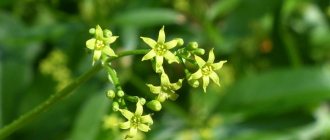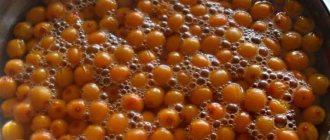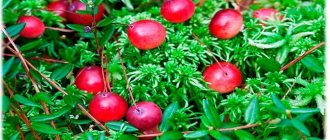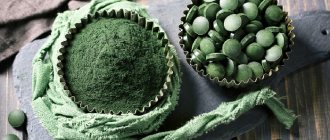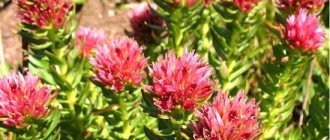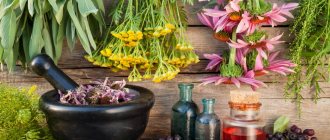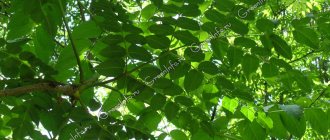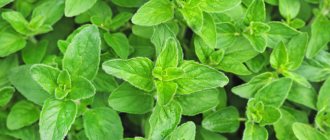The Latin name of one of the varieties of elecampane is Inula Helenium. They say that the plant got its name in honor of Helen of Troy. The ancient Greeks believed that the fiery yellow flowers of elecampane appeared in the places where Helen's tears fell when Paris kidnapped her from Sparta. This plant was also called Elenina grass in Rus'. Although there were other names - oman, divosil, wild sunflower, somnit.
Our ancestors considered this herb to be the source of “nine powers”. It is known that Russian warriors, when going on a campaign, always took with them crushed elecampane root, which served them as a talisman and protection from the enemy and evil forces. And women believed in another magical ability of Elena’s herb - love spell.
Botanical characteristics
Elecampane belongs to the same plant family as sunflowers and asters. There are almost two hundred varieties of this herb, but elecampane extract is most often used in herbal medicine. This is a tall perennial erect plant with a velvety stem and the same petals. The stem of elecampane is thick and fleshy, the leaves are large, oval, pointed at the ends. The sunny yellow flowers of elecampane could easily be confused with aster, if not for the extremely tall stem (mature grass grows up to 1.5-2 m in height). And many people call elecampane a smaller copy of sunflowers. Sunny flowers up to 10 cm in diameter appear, as a rule, in mid-summer and delight the eye until autumn.
Content:
- Botanical characteristics
- Beneficial features
- What the researchers say
- Elecampane in folk medicine
- Elecampane recipes
- Possible side effects
- How to grow
- How to prepare correctly
- How else are elecampane used?
The plant is distributed throughout Europe and in temperate latitudes of Asia. Thickets of elecampane are not uncommon in northwestern India and southern Siberia. It is also found in some US states.
Types and varieties
Royle's elecampane (Inula royleana)
- a perennial up to 60 cm high with oblong leaves up to 25 cm long and baskets with a diameter of 4-5 cm, consisting of bright yellow tubular and reed flowers. This species blooms in July-August. In culture since 1897.
- Replanting juniper - how to prepare mycorrhiza yourself
Elecampane (Inula rhizocephala)
– one of the most popular ornamental plant species in culture. The long, lanceolate leaves of elecampane are collected in a basal rosette, in the very middle of which there are compact, dense yellow inflorescences. The root system of this species is superficial and highly branched.
Eastern elecampane (Inula orientalis)
originally from the Caucasus and Asia Minor. This is a perennial up to 70 cm high with straight stems, oblong-spatulate leaves and baskets with a diameter of 9-10 cm of yellow tubular and dark yellow, very thin and long reed flowers. The species has been in cultivation since 1804.
Elecampane (Inula ensifolia)
can be found in forests, on mountain calcareous and chalk slopes and in the steppes of the Caucasus and Europe. This is a compact plant with a height of 15 to 30 cm with strong but thin stems branching in the upper part, narrow lanceolate sessile leaves up to 6 cm long and single yellow baskets with a diameter of 2 to 4 cm. The species has been in cultivation since 1793 and has a low-growing variety up to 20 cm high, which is characterized by abundant and long-lasting flowering.
Elecampane (Inula magnifica)
it is called so for good reason: it is a powerful, majestic and spreading perennial up to 2 m high with a thick grooved stem, large oblong basal and lower stem leaves up to 50 cm long and up to 25 cm wide. At the base, the leaves narrow and turn into a petiole up to 60 cm long. The upper ones The leaves of the plant are sessile and much smaller than the lower ones. Yellow flower baskets up to 15 cm in diameter are located one or several on peduncles up to 25 cm long, forming scutes. The magnificent elecampane blooms in July-August, but after the end of flowering it completely loses its decorative effect, so it is usually cut off.
British elecampane (Inula britannica)
in the wild it is found in the steppes, along ravines, along roadsides, in sedge swamps, in wet forest and salt marsh meadows, birch forests and in floodplain bush thickets of Europe and Asia. It is a low perennial, covered with grey-tomentose pubescence, with an erect, ribbed stem, simple or branched at the top and slightly reddish at the bottom. Its leaves are elliptical, lanceolate or linear-lanceolate, sometimes ovate, entire or finely toothed, with spines along the edges, acute, glabrous or slightly pubescent above, densely covered below with appressed woolly or glandular hairs. Yellow baskets up to 5 cm in diameter can be single or collected in loose shields.
Elecampane (Inula helenium)
grows in light pine and deciduous forests, meadows, along the banks of rivers in the Caucasus, Europe and Siberia. It is a perennial that forms a cylindrical bush up to 2.5 m high. It has a powerful, strong-smelling rhizome, oblong-elliptical basal and lower stem leaves 40-50 long and 15-20 cm wide. From the middle of the stem the leaves are sessile, with a stem-encompassing base . Golden-yellow baskets up to 8 cm in diameter are located on short peduncles in the axils of the bracts and form sparse racemes. This species has been in culture since ancient times.
Beneficial features
Since time immemorial, elecampane has been valued as an effective remedy against respiratory diseases. The herb extract has a warming effect on the respiratory system and promotes easy removal of phlegm. The plant has proven its benefits in the treatment of bronchitis, bronchial asthma, COPD (chronic obstructive pulmonary disease).
The herb and elecampane root taste bitter. And this property makes it useful for improving the functioning of the digestive system. Helena herb extract improves appetite, activates the stomach, and is also useful for removing parasites from the body.
Herbalists are well aware of another healing ability of elecampane. A medicine against tuberculosis has been prepared from the root of the plant for many years. The herb, as research confirms, has an antiseptic effect. And this fact explains why the plant extract is also used to treat infectious diseases, including influenza and tonsillitis.
In addition, this plant is believed to be useful for treating infertility and menstrual irregularities in women of all ages. It is good to drink decoctions of this herb for hemorrhoids, diabetes, epilepsy, general weakness and headaches.
Nutritional characteristics per 100 g of dry root
| Calorie content | 60 kcal |
| Cellulose | 38 g |
| Vitamin C | 2 mg |
| Vitamin B3 | 7 mg |
| Calcium | 1 g |
| Chromium | 0.1 mg |
| Cobalt | 0.18 mg |
| Iron | 0.4 mg |
| Magnesium | 750 mg |
| Manganese | 0.08 mg |
| Phosphorus | 150 mg |
| Potassium | 0.01 mg |
| Zinc | 0.39 mg |
Chemical composition of elecampane
The healing properties of elecampane are justified by its composition. The following substances are included in the composition of elecampane:
- inulin and inulenin are natural polysaccharides, one of the main sources of energy, involved in immune processes and ensure cell adhesion in tissues;
- saponins - relieve inflammation, enhance the secretion of bronchial glands, regulate water-salt and mineral metabolism, increase hormonal activity;
- resins - used as antibacterial, laxative and bacteriostatic agents;
- gum - reduces appetite, removes toxins from the body, reduces the amount of “bad” cholesterol, reduces irritation caused by certain pharmaceutical substances;
- mucus - has astringent, enveloping, expectorant and anti-inflammatory properties;
- acetic acid - used as an anti-inflammatory and astringent;
- benzoic acid - used internally as an expectorant, externally for skin diseases (as a disinfectant and antifungal);
- alkaloids - have antispasmodic, sedative, hypotensive and hemostatic properties;
- flavonoids - calm the nervous system, reduce the fragility of blood capillaries, enhance the effect of vitamin C;
- pectin - enhances the effect and mitigates the side effects of certain substances on the body, normalizes metabolism, reduces cholesterol, binds harmful substances and removes them from the body;
- helenin - improves the motor and secretory functions of the digestive tract, relieves cough, normalizes the functioning of the cardiovascular system;
- bitter substances - regulate metabolism, normalize blood sugar levels, slow down the fermentation process, restore kidneys, normalize the digestive tract, restore acid-base balance;
- vitamins - vitamin E, vitamin K, vitamin C;
- micro and macroelements: potassium, magnesium, calcium, manganese, iron.
What the researchers say
Back in 1804, scientists first isolated a substance from elecampane, which was later named inulin. By the way, this compound got its name from the Latin name elecampane. Inulin is the main component of the chemical composition of Elenina grass. In addition to it, the plant contains essential oils and saponins.
It has been established that inulin has a beneficial effect on the bronchi. Scientific experiments have shown that the amount of inulin in a plant varies depending on the season. The maximum concentration of the beneficial substance is observed in autumn. For example, a root dug up in October contains almost 45% inulin, while a spring sample contains only 19%. In the spring months, inulin is replaced from the root by other substances, such as levulin, mucus, glycosides, and simple carbohydrates.
Alantolactone, found in elecampane, is believed by researchers to have anti-inflammatory properties. In addition, this substance inhibits mucus secretion and strengthens the immune system.
Elecampane has a tonic, expectorant effect and stimulates coughing and removal of mucus from the lungs. By the way, it is believed that the essential oils contained in it impart these properties to the plant.
Elecampane in folk medicine
In folk medicine, the root of Elenina herb is most often used, although all parts of the plant have health benefits. It is believed that the most beneficial substances in the plant are concentrated in the second year of its growth. Two-year-old roots are usually collected in the fall.
Even in the ancient world, people used the medicine from elecampane to treat stomach disorders and relieve heaviness after overeating at luxurious banquets. Elenin's grass also enjoyed fame as a cure for colds. The ancients noticed that elecampane has a good diaphoretic effect.
Interestingly, in medieval Europe, a wine drink was prepared from the roots, which helped with stomach diseases. The monks called this medicine "Paul's drink", in honor of the apostle, who advised drinking a little of this drink to maintain a healthy stomach.
And in the 19th century in Europe they learned to cook elecampane in sugar syrup. The resulting sweet syrups, candies and lozenges were used to treat coughs and asthma. And adherents of all-natural medicines preferred to chew peeled elecampane root instead of sweets. At first, it does not taste or smell very pleasant, but when chewed, a pleasant odor is released from the root, reminiscent of the aroma of violet.
Herbalists use all parts of the plant to prepare medicines, from the bright yellow flowers to the roots. Tinctures, decoctions, and syrups are made from the herb.
Elecampane root has several medicinal properties. It is known as a natural antiseptic, diuretic, diaphoretic, and expectorant. In ancient times, herbalists used preparations from elecampane to treat women’s diseases, swelling, as well as diseases of the skin and joints.
A decoction of the root is useful for asthma, bronchitis, upper respiratory tract diseases, and hay fever. To prevent respiratory diseases, stimulate digestion and improve liver function, a non-concentrated decoction of the root can be taken on a regular basis. An alcohol tincture from the rhizomes of Elenina grass is useful for diseases of the respiratory system, and elecampane roots infused in red wine have anthelmintic properties. Syrup (boiled pieces of root in a sugar solution) is useful for coughs.
By the way, bright yellow elecampane flowers in the form of a decoction can also be a good medicine for a wet cough. The same remedy reduces nausea and stops vomiting. To eliminate digestive disorders, it is useful to drink teas from elecampane flowers in combination with ginger and licorice root.
External use of elecampane decoction will help get rid of many skin diseases, including eczema, rashes, and ulcers. Back in the 17th century, herbalists used a decoction of elecampane to wash rotting and poorly healing wounds. In addition, it is known that compresses from root tincture help relieve cramps, pain due to gout, radiculitis, and osteochondrosis.
Short description
Elecampane is valued for its medicinal capabilities.
Outwardly it looks like a bush. Grows up to two meters. Elongated leaves with sharp ends, straight stem, yellow or orange inflorescence. It grows mainly near a water source, in meadows and cliffs. With age, the plant becomes more useful. In two or three years it gains the necessary baggage of useful properties. It will not be difficult to find an elecampane bush, as it is found in every corner of Russia, as well as in the Caucasus region, Ukraine and other regions. The stems and leaves are multilayered, the upper ones are small and rigid, and the lower ones are larger. It is the second option that is used to treat various wounds, burns, and so on. Elecampane is recognized by its yellow inflorescence, which appears in mid-summer. But the flowers are not of particular value, so the grass is collected with the onset of autumn, when the flowers dry out and darkish cuttings form in their place.
The root is a storehouse of healing properties. He is hiding deep underground. He himself is brown in color. Root harvesting occurs in early spring or autumn. To do this, you will need to dig it up and carefully shake it off the ground, remove the root and stems. The rhizome is washed in cool water.
The maximum benefit of the plant is achieved through proper collection, for this you will need:
- Dig under the elecampane to thirty to forty centimeters, carefully so as not to spoil the rhizome system;
- Typically the main root is located within a twenty-five centimeter radius near the main stem;
- The root is washed with cool water;
- Divide into fairly small pieces for easy drying;
- Do not use an oven for drying, as the thermal method will destroy the beneficial properties;
- The drying process is best carried out in natural conditions, where there is fresh air;
- After drying, the root is crushed and placed in bags or jars.
The resulting product is stored for about three years. The root has a special aroma and bitter taste. The healing properties are associated with the rich composition, which contains vitamins, beneficial microelements and resin. They have a beneficial effect on a person’s condition and immunity, as well as on digestion.
Elecampane recipes
Tonic drink
This potion is prepared from fresh or dried elecampane roots. You will need about 30 g of fresh root, and no more than 50 g of dried root. In addition, take about half a glass of apple juice, a liter of water and 100 g of sugar or honey. A decoction is prepared from water and roots (cook for about half an hour). Honey (sugar) and apple juice are added to the slightly cooled brew. It is useful to drink such a tasty medicine three times a day, 3 tablespoons.
Medicine for tachycardia
It is very easy to prepare: just mix dry elecampane roots and vodka (alcohol) in a 1:2 ratio. It is recommended to infuse the medicine in a dark place for 14 to 21 days. Then take a teaspoon before meals.
Tincture for the treatment of lungs
If you drink this medicine a tablespoon before each meal for at least 2 months, the health status of chronic lung diseases, including tuberculosis, will noticeably improve. The preparation is prepared from ground fresh roots and vodka. Take 250 ml of alcohol per glass of elecampane root pulp and leave for 9-14 days.
For cough treatment
This decoction is suitable for treating coughs in children and adults. It is prepared from a tablespoon of dry roots and a glass of water. Cook for about 15 minutes, then wrap in a warm towel and leave for another half hour. Take a tablespoon several times a day.
Remedy for skin diseases
For the treatment of skin diseases, washing wounds and burns, a decoction of 110 g of crushed roots and a liter of water is suitable. Cook over low heat for at least 3 hours.
To improve male and female fertility
To increase the chances of successful conception, it is useful for men and women to drink a decoction of Elenina herb. Take a tablespoon of finely chopped roots for a glass of boiling water. Cook in a water bath for about a quarter of an hour. Take a tablespoon every 2 hours. Drink for 3 days, then take a week break and resume treatment.
For weight loss
Interestingly, elecampane is a useful tool for combating excess weight. No, scientists have not found any components in this plant that could miraculously break down fat deposits. But elecampane has another beneficial property - it dulls the feeling of hunger, curbs appetite and at the same time strengthens the immune system, improves mood and gives energy (it was not for nothing that ancient gladiators used powder from elecampane root as an energy drink). So, to fight appetite and excess weight, you will need about 50 g of crushed grass roots and a glass of cold boiled water. Mix the ingredients and leave overnight. Drink in the morning. One portion of roots can be infused three times, then take a fresh portion of elecampane. They say that the “brutal appetite” disappears already on the third day of treatment.
Possible side effects
Elecampane is a useful medicinal plant, but it can be dangerous for some people. We are talking about people prone to allergies. If a person has had allergic reactions to chamomile, echinacea, or pyrethrum, then elecampane will most likely cause an allergy. A reaction to the plant may include vomiting, diarrhea and cramps.
Preparations from elecampane are prohibited for pregnant women (the plant stimulates the uterus), for kidney dysfunction and cardiac disorders.
Elecampane: harm and contraindications
Elecampane, the use of which at home has become quite popular, has a number of contraindications. It should be noted that the plant is used with caution for:
- diseases of the kidneys, heart and blood vessels;
- gastritis, accompanied by a decrease in the acidity of gastric juice;
- peptic ulcer during exacerbations;
- pregnancy and gynecological diseases, especially in the case of a tendency to heavy menstruation.
Elecampane: pixabay.com
When using elecampane for cough or for any other purpose, it is important to strictly follow the dosage prescribed in the recipes. Exceeding the concentration of active substances and excessive consumption can lead to the development of allergic reactions, severe stomach pain, and vomiting.
Before giving elecampane to children and adults, it is recommended to consult a doctor and choose the option of use that will bring maximum benefit and will not cause deterioration in well-being.
How to grow
Best materials of the month
- Coronaviruses: SARS-CoV-2 (COVID-19)
- Antibiotics for the prevention and treatment of COVID-19: how effective are they?
- The most common "office" diseases
- Does vodka kill coronavirus?
- How to stay alive on our roads?
In addition to wild elecampane plants, people also use specially cultivated varieties of grass. Elenina grass reproduces in two ways: by seeds and by dividing the roots. The plant prefers moist and well-drained soil. Grows well in shaded areas of the garden.
Seeds are sown in open soil in the spring. But a more effective way is using root cuttings taken from mature plants. Root cuttings are usually harvested in the fall. During the winter they are kept in the basement, and in the spring, when the danger of frost has passed, they are planted in the soil. Each root is rooted at a distance of 25-30 cm from each other. To improve growth, the soil can be dug up before planting (or in the fall). In the first year of growth, elecampane requires care and protection, in particular from frost (it is better to insulate young plants during the cold season). In the second year, you can already harvest greens and roots of medicinal herbs.
Growing in the garden
Tall elecampane can also be grown in a garden plot. You can choose a sunny place for it, but not too much shade. It is imperative to add humus for good growth. Elecampane is propagated by seeds, seedlings or dividing a bush. Seeds or seedlings are planted in late autumn or early spring according to a 50x30 cm or 50x50 cm pattern.
In the first year, plants develop slowly. They need to be watered and fed with complex fertilizer, bird droppings or slurry. Nitrogen fertilizers are used until August, after which only potassium and phosphorus are allowed. In the second year, plants grow much faster and are not as demanding to care for.
Elecampane is very responsive to watering, although adult plants can tolerate short-term drought without much harm. In the second year you can dig up the roots, but it is better to wait another year or two, this will make their medicinal properties much greater.
Castor bean: planting, growing, care and maintenance at home and outdoors (115 photos and videos)Bergenia - tips for properly growing a medicinal plant. Features of collection, application and contraindications (130 photos and videos of planting in the ground)
Cloudberries: beneficial properties, features of cultivation and use. Planting, care and propagation with your own hands (150 photos and videos)
